Hotpoint NBXR333 User Manual

Dryers
Hotpoint.com
Safety Instructions . . . . . . . . 2–4
Operating Instructions
Control Panel . . . . . . . . . . . . . . . . . . . 5
Control Settings . . . . . . . . . . . . . . . . . 6
Features . . . . . . . . . . . . . . . . . . . . . . . .7
Loading and Using
the Dryer . . . . . . . . . . . . . . . . . . . .9, 10
Reversing the Door . . . . . . . . . . . . . . 8
Venting the Dryer . . . . . . . . . . . . . .10
Troubleshooting Tips . . . 11, 12
Consumer Support
Consumer Support . . . . . Back Cover
Warranty . . . . . . . . . . . . . . . . . . . . . 15
Write the model and serial numbers here:
Model # __________________
Serial # __________________
You can find them on a label on the front of the dryer behind the door.
Owner’s Manual
NBXR333
NVLR223
NWXR483
175D1807P568 39-90300-1 11-06 JR
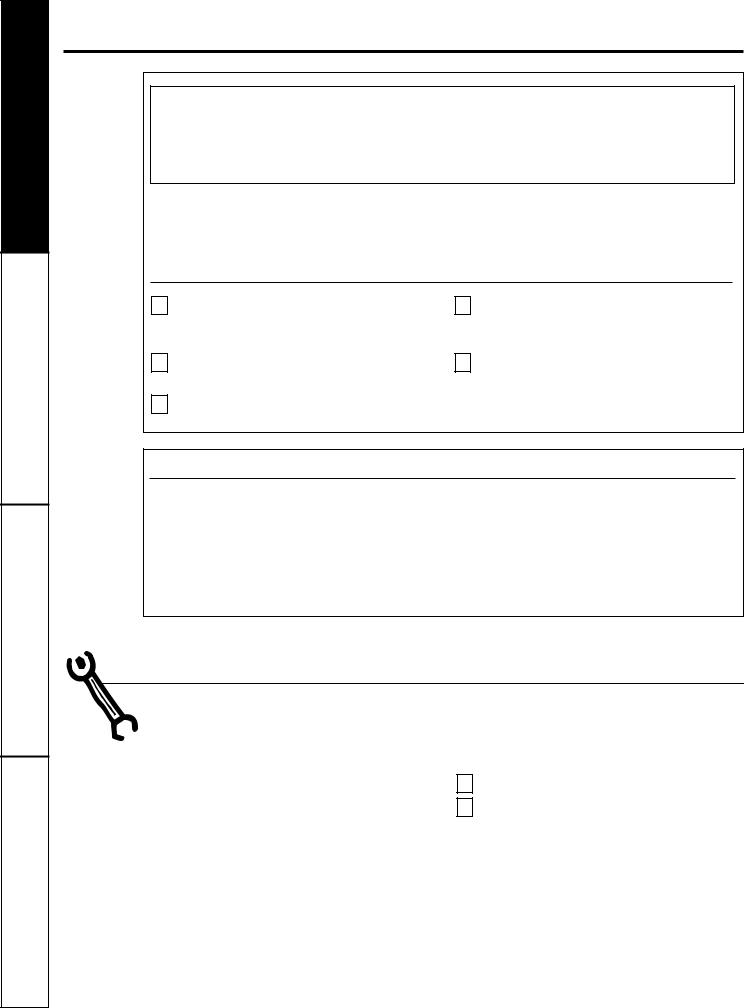
Safety Instructions
Operating Instructions
Troubleshooting Tips
Consumer Support
IMPORTANT SAFETY INFORMATION.
READ ALL INSTRUCTIONS BEFORE USING.
 WARNING!
WARNING!
For your safety, the information in this manual must be followed to minimize the risk of fire or explosion, electric shock, or to prevent property damage, personal injury, or death.
■ Do not store or use gasoline or other |
■ Installation and service must be |
flammable vapors and liquids in the |
performed by a qualified installer, |
vicinity of this or any other appliance. |
service agency or the gas supplier. |
|
|
WHAT TO DO IF YOU SMELL GAS:
1
2
3
Do not try to light a match, or cigarette, or turn on any gas or electrical appliance.
Do not touch any electrical switch; do not use any phone in your building.
Clear the room, building or area of all occupants.
4
5
Immediately call your gas supplier from a neighbor’s phone. Follow the gas supplier’s instructions carefully.
If you cannot reach your gas supplier, call the fire department.
California Safe Drinking Water and Toxic Enforcement Act
This act requires the governor of California to publish a list of substances known to the state to cause cancer, birth defects or other reproductive harm and requires businesses to warn customers of potential exposure to such substances.
Gas appliances can cause minor exposure to four of these substances, namely benzene, carbon monoxide, formaldehyde and soot, caused primarily by the incomplete combustion of natural gas or LP fuels.
Properly adjusted dryers will minimize incomplete combustion. Exposure to these substances can be minimized further by properly venting the dryer to the outdoors.
PROPER INSTALLATION
This dryer must be properly installed and located in accordance with the Installation Instructions before it is used. If you did not receive an Installation Instructions sheet, you can receive one by visiting Hotpoint.com, or by calling 800.GE.CARES (800.432.2737).
■Properly ground dryer to conform with all governing codes and ordinances. Follow details in Installation Instructions.
■Install or store where it will not be exposed to temperatures below freezing or exposed
to the weather, which could cause permanent damage and invalidate the warranty.
■Connect to a properly rated, protected and sized power supply circuit to avoid electrical overload.
■Remove all sharp packing items and dispose of all shipping materials properly.
Exhaust/Ducting:
1 Gas dryers MUST be exhausted to the outside.
2Use only rigid metal 4″ diameter ductwork inside the dryer cabinet. Use only rigid metal or flexible metal 4″ diameter ductwork for exhausting to the outside. USE OF PLASTIC OR
OTHER COMBUSTIBLE DUCTWORK CAN CAUSE A FIRE. PUNCTURED DUCTWORK CAN CAUSE A FIRE IF IT COLLAPSES OR BECOMES OTHERWISE RESTRICTED IN USE OR DURING INSTALLATION.
For complete details, follow the Installation Instructions.
2

Hotpoint.com
 WARNING!
WARNING!
YOUR LAUNDRY AREA
■Keep the area underneath and around your appliances free of combustible materials (lint, paper, rags, etc.), gasoline, chemicals and other flammable vapors and liquids.
■Keep the floor around your appliances clean and dry to reduce the possibility of slipping.
■Close supervision is necessary if this appliance is used by or near children. Do not allow children to play on, with or inside this or any other appliance.
■Keep all laundry aids (such as detergents, bleaches, etc.) out of the reach of children, preferably in a locked cabinet. Observe all warnings on container labels to avoid injury.
■Never climb on or stand on the dryer top.
WHEN USING YOUR DRYER
■Never reach into the dryer while the drum is moving. Before loading, unloading or adding clothes, wait until the drum has completely stopped.
■Clean the lint filter before each load to prevent lint accumulation inside the dryer or in the room. DO
NOT OPERATE THE DRYER WITHOUT THE LINT FILTER IN PLACE.
■Do not wash or dry articles that have been cleaned in, washed in, soaked in or spotted
with combustible or explosive substances (such as wax, oil, paint, gasoline, degreasers, dry-cleaning solvents, kerosene, etc.). These substances give off vapors that may ignite or explode. Do not add these substances to the wash water. Do not use or place these substances around your washer or dryer during operation.
■Do not place items exposed to cooking oils in your dryer. Items contaminated with cooking oils may contribute to a chemical reaction that could cause a clothes load to catch fire.
■Any article on which you have used a cleaning solvent or that contains flammable materials (such as cleaning cloths, mops, towels used in beauty salons, restaurants, or barber shops, etc.) must not be placed in or near the dryer until solvents or flammable materials have been removed. There are many highly flammable items used in homes such as acetone, denatured alcohol, gasoline, kerosene, some household cleaners, some spot removers, turpentines, waxes, wax removers
and products containing petroleum distillates.
■The laundry process can reduce the flame retardancy of fabrics. To avoid such a result, carefully follow the garment manufacturer’s care instructions.
■Do not dry articles containing rubber, plastic
or similar materials such as padded bras, tennis shoes, galoshes, bath mats, rugs, bibs, baby pants, plastic bags, pillows, etc. that may melt or burn. Some rubber materials, when heated, can under certain circumstances produce fire by spontaneous combustion.
■Do not store plastic, paper or clothing that may burn or melt on top of the dryer during operation.
■Garments labeled Dry Away from Heat or Do Not Tumble Dry (such as life jackets containing Kapok) must not be put in your dryer.
■Do not dry fiberglass articles in your dryer. Skin irritation could result from the remaining particles that may be picked up by clothing during subsequent dryer uses.
■To minimize the possibility of electric shock, unplug this appliance from the power supply or disconnect the dryer at the household distribution panel by removing the fuse or switching off the circuit breaker before attempting any maintenance or cleaning (except the removal and cleaning of the lint filter). NOTE: Turning the Cycle Selector knob
to an off position or pressing PAUSE does NOT disconnect the appliance from the power supply.
3
Instructions Safety
Instructions Operating
Tips Troubleshooting
Support Consumer
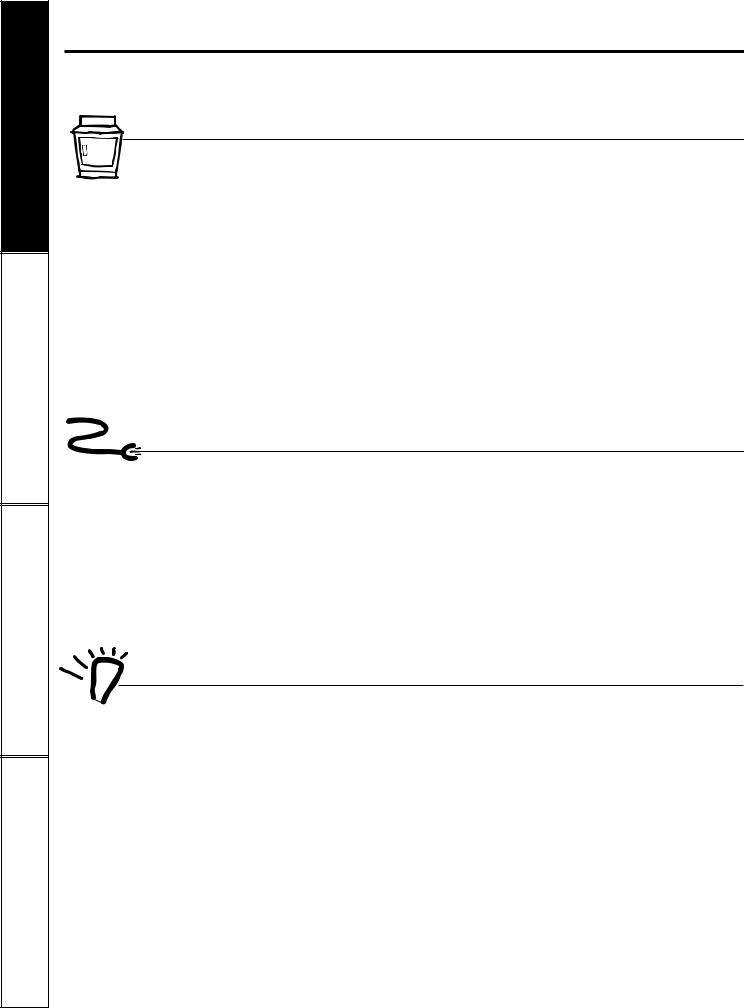
Safety Instructions
Operating Instructions
Troubleshooting Tips
Consumer Support
IMPORTANT SAFETY INFORMATION. READ ALL INSTRUCTIONS BEFORE USING.
 WARNING!
WARNING!
WHEN USING YOUR DRYER (cont.)
■Never attempt to operate this appliance if it is damaged, malfunctioning, partially disassembled, or has missing or broken parts, including a damaged cord or plug.
■The interior of the machine and the exhaust duct connection inside the dryer should be cleaned at least once a year by a qualified technician. See the Loading and Using the Dryer section.
■If yours is a gas dryer, it is equipped with an automatic electric ignition and does not have
a pilot light. DO NOT ATTEMPT TO LIGHT WITH A MATCH. Burns may result from having your hand in the vicinity of the burner when the automatic ignition turns on.
■You may wish to soften your laundered fabrics or reduce the static electricity in them by using a dryer-applied fabric softener or an anti-static conditioner. We recommend you use either a
fabric softener in the wash cycle, according to the manufacturer’s instructions for those products, or try a dryer-added product for which the manufacturer gives written assurance on the package that their product can be safely used
in your dryer. Service or performance problems caused by use of these products are the responsibility of the manufacturers of those products and are not covered under the warranty to this appliance.
WHEN NOT USING YOUR DRYER
■Grasp the plug firmly when disconnecting this appliance to avoid damage to the cord while pulling. Place the cord away from traffic areas so it will not be stepped on, tripped over or subjected to damage.
■Do not attempt to repair or replace any part
of this appliance or attempt any servicing unless specifically recommended in this Owner’s Manual or in published user-repair instructions that you understand and have the skills to carry out.
■Before discarding a dryer, or removing it from service, remove the dryer door to prevent children from hiding inside.
■Do not tamper with controls.
 READ AND FOLLOW THIS SAFETY INFORMATION CAREFULLY.
READ AND FOLLOW THIS SAFETY INFORMATION CAREFULLY.


 SAVE THESE INSTRUCTIONS
SAVE THESE INSTRUCTIONS
4

About the dryer control panel. |
Hotpoint.com |
You can locate your model number on the label on the front of the dryer behind the door. Throughout this manual, features and appearance may vary from your model.
Model NVLR223
3 |
2 |
Model NBXR333
3 |
1 |
2 |
Model NWXR483
3 |
1 |
2 |
NOTE: Drying times will vary according to the type of heat used (Electric, Natural or LP gas), size of load, types of fabrics, wetness of clothes and condition of exhaust ducts.
5
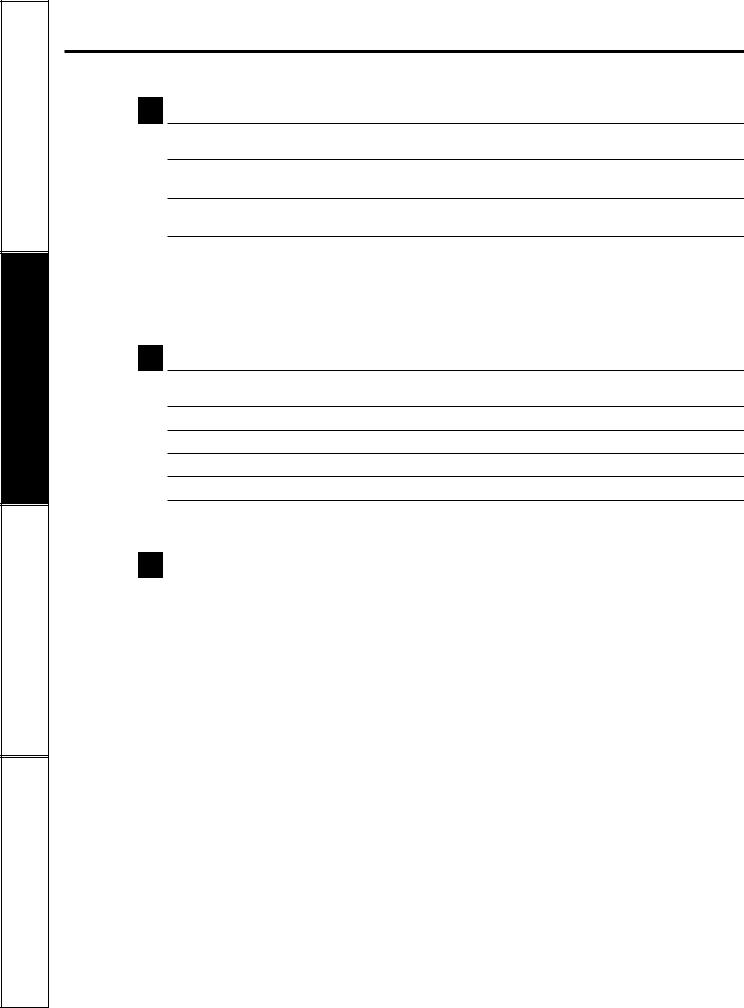
Safety Instructions
Operating Instructions
Troubleshooting Tips
Consumer Support
About the control settings.
IMPORTANT: Clean the lint filter each time you use the dryer.
1 Fabric Care/Temperature (on some models)
COTTONS For regular to heavy cottons.
REGULAR
WRINKLE FREE For synthetics, blends, delicates and items labeled permanent press.
MEDIUM
KNITS/DELICATES On some models. For delicates, synthetics and items labeled tumble dry low.
LOW
FLUFF For fluffing items without heat. Use the TIMED DRY cycle.
NO HEAT
Automatic cycles automatically determine fabric dryness. Select LESS DRY if you want your clothes slightly damp at the end of the drying cycle. Select MORE DRY if you want them to feel drier. Timed cycles run for a selected time.
2 Drying Cycles
COTTONS For cottons and most linens. For most loads select OPTIMUM DRY (on some models) or select the Preferred Regular Setting marked with an *.
WRINKLE FREE For wrinkle-free, permanent press and delicate items, and knits.
TIMED DRY Set the Cycle Selector at the desired drying time.
DAMP DRY For leaving items partially damp.
DEWRINKLE For removing wrinkles from items that are clean and dry or that are very lightly damp.
FLUFF or For freshening or fluffing up already dry clothing, fabrics, linens and pillows. Use with QUICK FLUFF FLUFF NO HEAT. Provides 10 minutes of no heat tumbling.
3 Start— Close the dryer door. Select START. Opening the door during operation will stop the dryer. To restart the dryer, close the door and select START to complete the cycle.
6
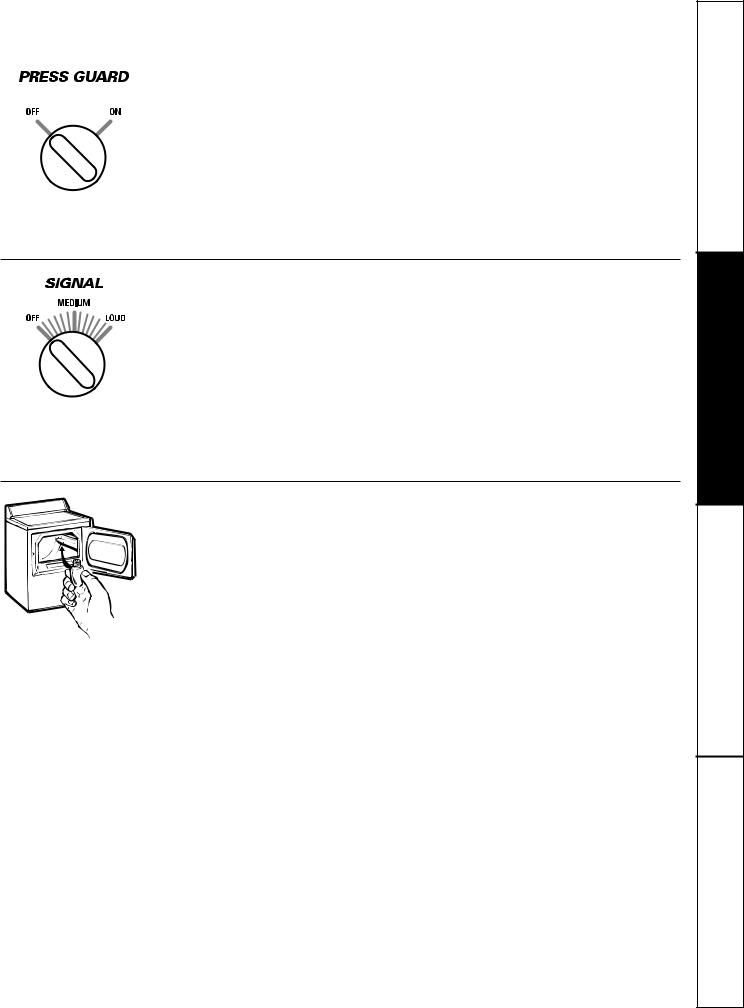
About the dryer features. |
Hotpoint.com |
Press Guard Option (on some models)
Use this option to minimize the wrinkles in clothes. It provides approximately 15 minutes of no-heat tumbling after the clothes are dry.
This option can only be used with the
COTTONS and WRINKLE FREE cycles.
If you are using the SIGNAL knob and you select the PRESS GUARD option, a signal will sound at the end of the drying time and several times during the PRESS GUARD cycle. This will remind you that it is time to remove the clothes.
If PRESS GUARD is not on, the dryer will stop once the timer reaches the PRESS GUARD mark on the cycle dial.
Cycle Signal Option (on some models)
This signal will sound just before the end of the cycle to remind you to remove the clothes. On some models, the signal sound level cannot be adjusted.
If you selected the PRESS GUARD option, the signal will sound at the end of the drying time and will sound several times during the PRESS GUARD cycle. This will remind you that it is time to remove the clothes.
NOTE:
■Remove garments promptly at the sound of the signal. Place clothes on hangers so wrinkles won’t set in.
■Use the Cycle Signal especially when drying fabrics like polyester knits and permanent press. These fabrics should be removed so wrinkles won’t set in.
Drum Lamp (on some models)
Before replacing the light bulb, be sure to unplug the dryer power cord or disconnect the dryer at the household distribution panel by removing the fuse or switching off the circuit breaker. Reach above dryer opening from inside the drum. Remove the bulb and replace with the same size bulb.
7
Instructions Safety
Instructions Operating
Tips Troubleshooting
Support Consumer
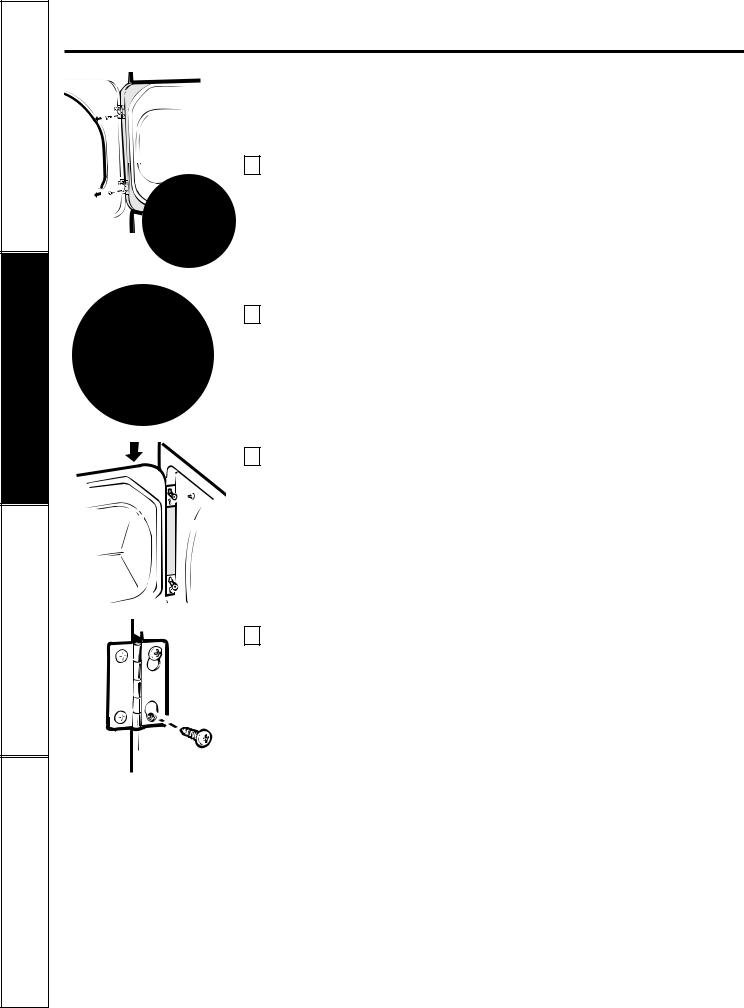
Safety Instructions
Operating Instructions
Troubleshooting Tips
Consumer Support
About reversing the door.
Reversing the Door
Tools needed:
■ Standard #2 ■ Tape-tipped Phillips screwdriver putty knife
1 Open the door and remove the filler plugs opposite the hinges. With the door completely open, remove the bottom screw from each hinge on the dryer face. Insert these screws about half way into the TOP holes, for each hinge, on the opposite side (where you removed the filler plugs). Apply firm pressure to get the screw started in new holes.
2 Loosen top screw from each hinge on the dryer face half way. With one hand holding the top of the door and the other hand holding the bottom, remove the door from the dryer by lifting it UP and OUT.
3Rotate the door 180°. Insert it on the opposite side of the opening by moving the door IN and DOWN until the top hinge and the bottom hinge are resting on the top screws inserted in step 1.
4 Remove the remaining screws from the side of the opening from which the door was removed. With these screws, secure each hinge at the bottom. Tighten the 2 top screws of each hinge. Reinsert the plastic plugs on the side from which the door was removed.
8
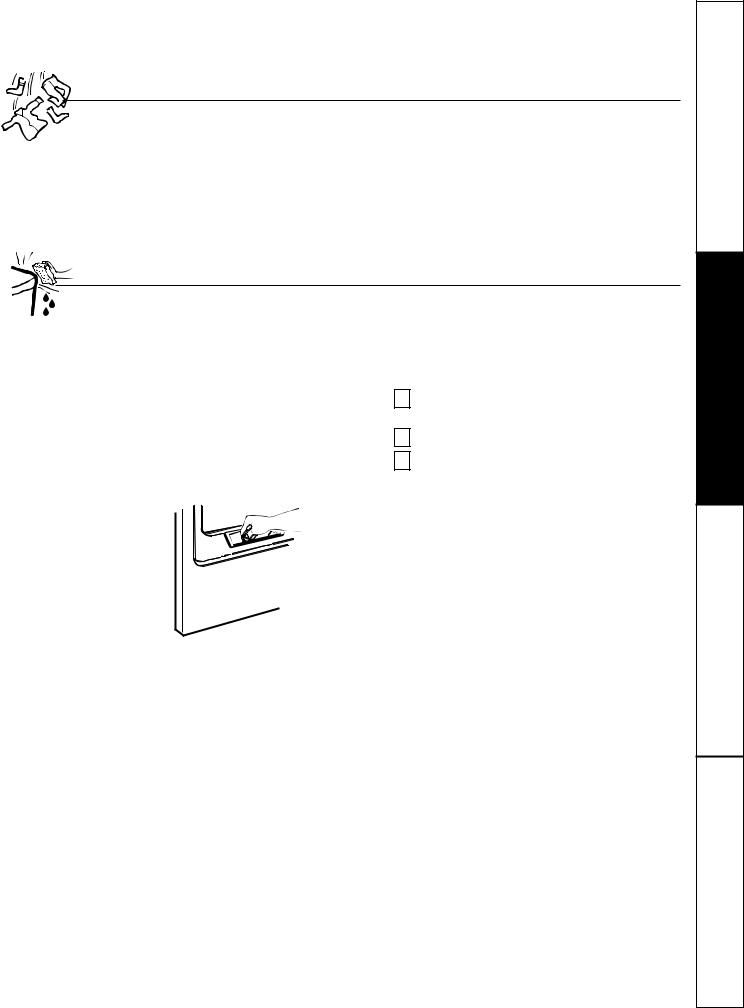
Loading and using the dryer.
Always follow the fabric manufacturer’s care label when laundering. |
Hotpoint.com |
Sorting and Loading Hints
As a general rule, if clothes are sorted properly for the washer, they are sorted properly for the dryer.
Do not add fabric softener sheets once the load has become warm. They may cause fabric softener stains. Bounce® Fabric Conditioner Dryer Sheets have been approved for use in all GE Dryers when used in accordance with the manufacturer’s instructions.
Do not overload. This wastes energy and causes wrinkling.
Do not dry the following items: fiberglass items, woolens, rubber-coated items, plastics, items with plastic trim and foam-filled items.
Care and Cleaning of the Dryer
The Exterior: Wipe or dust any spills or washing compounds with a damp cloth. Dryer control panel and finishes may be damaged by some laundry pretreatment soil and stain remover products. Apply these products away from the dryer. The fabric may then be washed and dried normally. Damage to your dryer caused by these products is not covered by your warranty.
The Lint Filter: Clean the lint filter before each use. Moisten your fingers and reach into the filter opening. Run your fingers across the filter. Have a qualified technician vacuum the lint from the dryer once
a year.
The Exhaust Duct: Inspect and clean the exhaust ducting at least once a year to prevent clogging. A partially clogged exhaust can lengthen the drying time.
Follow these steps:
1Turn off electrical supply by disconnecting the plug from the wall socket.
2 Disconnect the duct from the dryer.
3Vacuum the duct with the hose attachment and reconnect the duct.
The Exhaust Hood: Check from the outside that the flaps of the hood move freely when operating. Make sure that there is no wildlife (birds, insects, etc.) nesting inside the duct or hood.
9
Instructions Safety
Instructions Operating
Tips Troubleshooting
Support Consumer
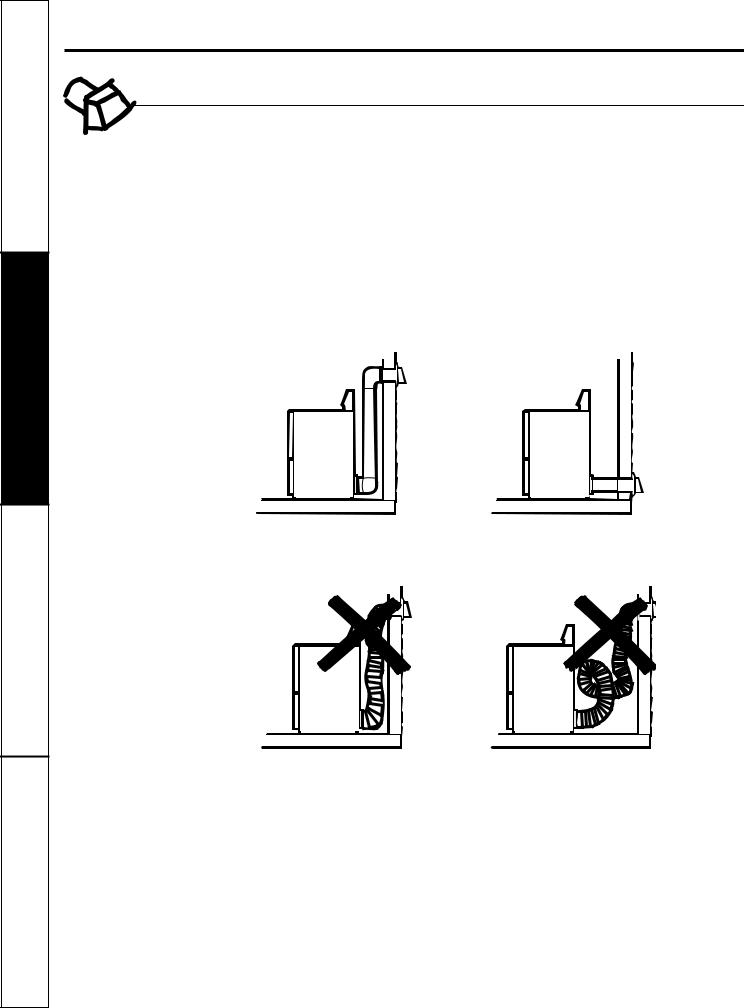
Safety Instructions
Operating Instructions
Troubleshooting Tips
Consumer Support
Loading and using the dryer. Always follow the fabric manufacturer’s care label when laundering.
Venting the Dryer
For the best drying performance, the dryer needs to be properly vented. The dryer will use more energy and run longer if it is not vented to the below specifications. Carefully follow the details on Exhausting in the Installation Instructions.
■Use only rigid metal 4″ diameter ductwork inside the dryer cabinet. Use only rigid metal or flexible metal 4″ diameter ductwork for exhausting to the outside.
■Do not use plastic or other combustible ductwork.
■Use the shortest length possible.
■Do not crush or collapse.
■Avoid resting the duct on sharp objects.
■Venting must conform to local building codes.
Correct
Venting
Incorrect
Venting
10
